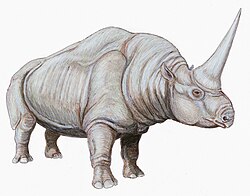| Protapirus | |
|---|---|
 | |
| Protapirus simplex skull from South Dakota. At the AMNH. | |
 | |
| 1913 illustration of P. simplex, depicted without a trunk. | |
| Scientific classification | |
| Kingdom: | Animalia |
| Phylum: | Chordata |
| Class: | Mammalia |
| Order: | Perissodactyla |
| Family: | Tapiridae |
| Genus: | † Protapirus Filhol, 1877 |
| Type species | |
| †Protapirus priscus Filhol, 1874 | |
| Species | |
| |
Protapirus (Latin: "before" (pro), + Brazilian Indian: "tapir" (tapira) [1] ) is an extinct genus of tapir known from the Oligocene and Miocene of North America and Eurasia. [2]










